Lucifer Hummingbirds (Calothorax lucifer) are medium-sized hummingbirds generally found in Mexico, but their breeding range also extends into some southwestern states of the United States.
Males have a vibrant iridescent purple forget, while females are more modest. They are not a common sight in the United States, so if you’re unsure whether you saw one or not, then here is some more information to help you decide.
On this page
Identification
Lucifer Sheartails are medium-sized hummingbirds, measuring 3.9 inches long. They typically have a streamlined body and long, black, and downcurved bills, which makes them look slightly out of proportion.
Male
Male Lucifer Sheartails have mostly iridescent plumage. Their uppersides and crown are green, their underparts are whitish, and they have dirty green flanks, dark wings and tails, and an iridescent throat patch (also known as ‘gorget’). They have a dark, narrow, and long forked tail that extends well past their wing tips.
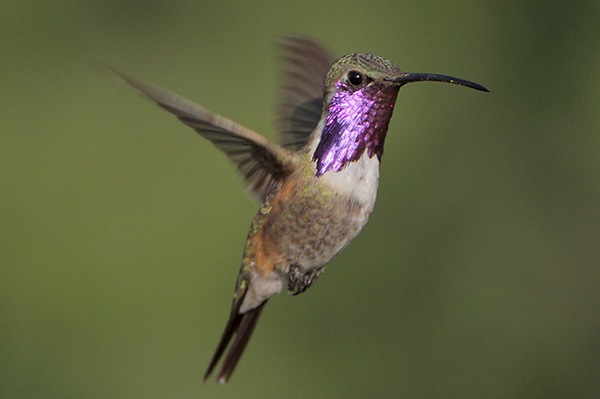
Immature males resemble females and have a buff or peachy wash on their underside. They also have a pale buffy line running across their eyes and a few iridescent purple specks on their throats.
Female
Females, in contrast, typically have more subdued and camouflaged plumage compared to males. They have green upperparts and whitish underparts with pale rust-colored flanks. Their throat is also dingy and they have a pale stripe running from the corner of their eye. They have shorter tails compared to males.
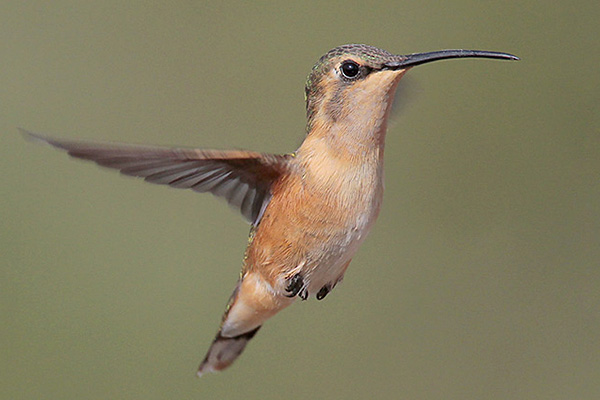
Photograph © Greg Lavaty.
Juvenile plumage in Lucifer Hummingbirds is often similar to that of adult females. Young birds may lack the full brilliance of adults but gradually acquire more vibrant colors as they mature.
Vocalizations
Lucifer Hummingbirds produce short, high-pitched chips during flight or when interacting with other hummingbirds. These sounds can serve as communication signals, especially in the context of defending territories or attracting mates. They also emit quiet brzhee-brzhee sounds. During courtship, males make snapping sounds when trying to impress females.
Food
Lucifer Hummingbirds, like other hummingbirds, primarily feed on nectar from flowers as their main energy source and supplement it with insects.
These birds have specialized long and slender bills and extendable tongues adapted for extracting nectar from flowers while hovering. They are attracted to brightly colored and tubular flowers such as agave, penstemon, paintbrush, willow, cholla, and trumpet flowers.
Unsurprisingly, these agile fliers are also quite adept at capturing tiny insects. They either snatch them mid-air, take them from spider webs, or glean them from foliage. The animal part of their diet is especially important during the breeding season, as the female feeds mostly insects to her young.
Lucifer Hummingbirds also visit hummingbird feeders for sugar water. They either perch or many also hover when feeding. Generally, they like to feed in the morning.
Nesting and Eggs
Lucifer Hummingbirds, as hummingbirds in general, are not monogamous, and males mate with many females. However, there is a slight difference in their courtship behavior. While usually females approach males in their territory, then in this case the males approach females who are building their nest and display to them.
This display is described as the male flying back and forth between perches near the female, rustling with their wings, flying high up above, and then diving past the nest, accompanied by various sounds produced by his wings and tail.
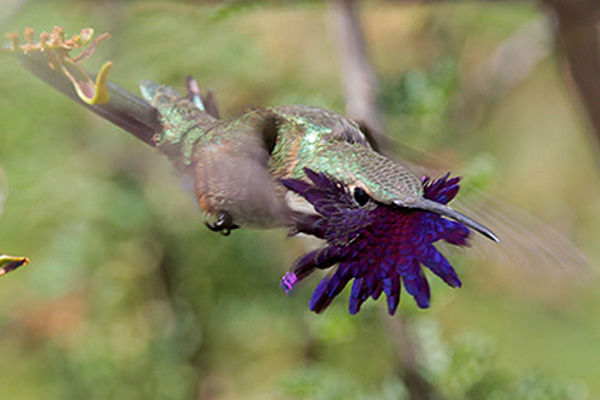
Lucifer Hummingbird’s display is quite elaborate
Females build the nests 2-10 feet above the ground on a stem and among leaves of ocotillo, on an agave stalk, on Lechuguilla plants, or in open cholla cacti. The plants chosen are generally on steep and rocky slopes.
Lucifer Hummingbird nests are small, slightly under two inches across and a bit over two inches tall. It is an open cup made of spider silk and various fine plant fibers such as dried grass, small twigs, and oak catkins. The inside of the nest is lined with plant down while the outside is camouflaged with small leaves and lichens.
This species can have up to two broods in a year, with mostly two white eggs in a clutch.
Lucifer Hummingbird eggs are very small, only 0.5-0.6 inches long and 0.3-0.4 inches wide. The mother bird incubates them for about 15 days. She then takes care of her offspring by brooding them at night and regurgitating a mix of insects and nectar into their throats. Younglings leave the nest at about 22-24 days of age.
Current Situation
Lucifer Hummingbirds range throughout central and northern Mexico. They winter in central Mexico and fly to northern Mexico for the breeding season, with their breeding range slightly extending into southeast Arizona, southwest New Mexico, and west Texas.
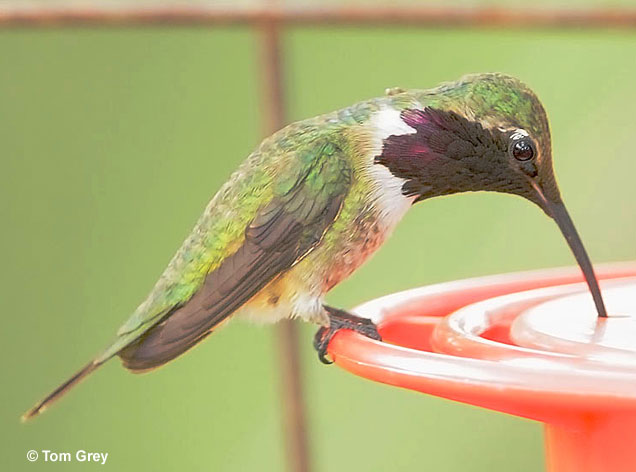
Lucifer Hummingbird habitats vary depending on where they are.
In the United States, they specifically inhabit the canyons, scrubs, and dry washes of Chihuahuan desert foothills between 3,500 and 5,500 feet. During winter in Mexico, they are found in similar habitats and also in pine-oak woods or canyons in tropical deciduous forests.
Lucifer Hummingbird is listed as of least concern on the IUCN Red List. It is estimated that there are 200,000 mature individuals and the population is stable, but there is little actual information about it.
Facts
- Lucifer Hummingbirds are also known as Lucifer Sheartails.
- Lucifer Hummingbirds’ average lifespan in the wild is about 4 years. The oldest specimen on record was at least 7 years and 5 months old.
- These hummingbirds are a bit different when it comes to their courtship habits. In other species, the female approaches the male territory, and the male then tries to woo her. However, when it comes to Lucifer Hummingbirds, then males approach females at their nest sites and start displaying.
- Female Lucifer Hummingbirds are aggressive towards each other and often steal each others’ nest material.
Similar Species
Lucifer Hummingbirds have a few similar species with Costa’s Hummingbird being the closest match. Luckily, there are some easy ways to tell which is which. Let’s take a closer look.
Black-chinned Hummingbird
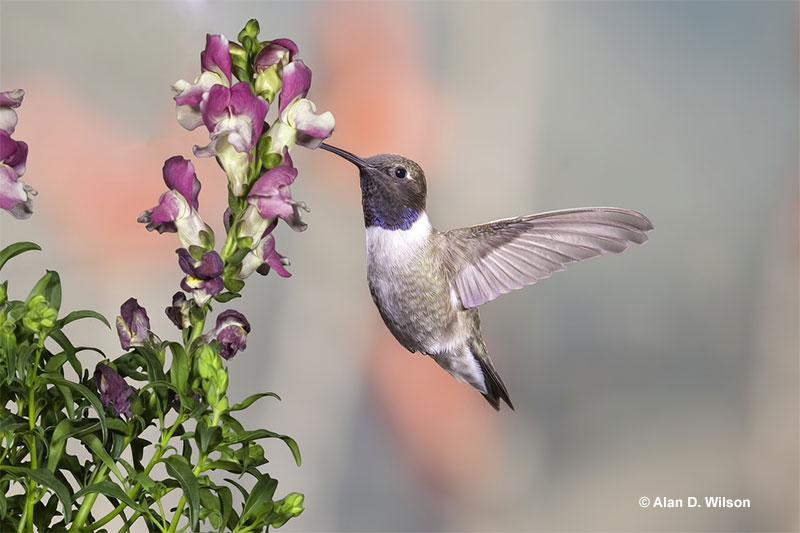
Black-chinned Hummingbirds have a far wider range that extends from central Mexico to southwestern Canada. Male Black-chinned Hummingbirds are dull iridescent green above, grayish-white below with dirty greenish flanks, and they have a dark head and throat with an iridescent purple base. Females are similar, but duller, have lighter heads and a pale throat, and less green on their flanks.
In bad lighting or at a bad angle, males may look very similar as male Lucifer’s gorget may seem dark, even black as well. However, even if you can’t spot the iridescent purple of the Lucifer, there are other ways to tell them apart. Lucifer’s gorget is more extensive and flares off to the sides, they have longer tails, and their bill is curved instead of straight.
Costa’s Hummingbird
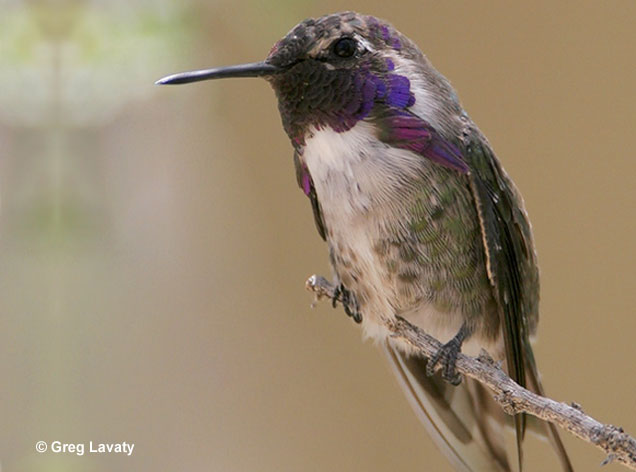
Costa’s Hummingbirds have a more restricted range and are found in Baja California, along the northwest coast of Mexico, and in the northern half of California, Nevada, and Arizona, so the range overlap is minimal. Male Costa’s Hummingbirds have a green back, a whitish underside with pale green flanks, and iridescent dark purple gorgets and foreheads. Females are similar but lack the gorgets and don’t have green on their flanks.
Despite similar coloring, you can still easily tell them apart. Lucifer Hummingbirds are more slender and have a curved bill whereas Costa’s Hummingbirds have a straight bill.
Male Lucifers lack the iridescent purple on their foreheads and their gorgets don’t flare as much. For females, look at their bills and undersides. Lucifer has peachy flanks and a curved bill, whereas Costa’s has overall whitish undersides and a straight bill.
Broad-tailed Hummingbird
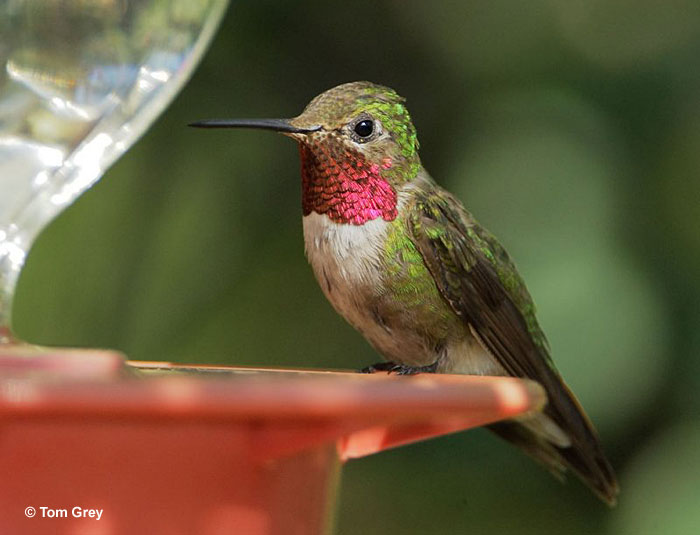
Broad-tailed Hummingbirds have a fairly fragmented range throughout Mexico and the western United States. Males are vibrant iridescent green above with green flanks, white undersides, and rosy-red gorgets. Females are similar but have rust-colored flanks and white throats with green spotting.
If you have good lighting, it is fairly easy to tell males apart. Broad-tailed males have rosy-red gorgets and overall more vibrant plumage as opposed to the slightly duller plumage and purple gorget of the male Lucifer’s. Lucifer also has a curved bill instead of a straight one. Females are quite similar, but female Broad-tails have pale throats with green spots whereas the throats of female Lucifers are plain.
Frequently Asked Questions
How did Lucifer Hummingbirds get their name?
Lucifer Hummingbirds got their name from their beautiful iridescent gorget. Its scientific name Calothorax lucifer helps to shine a bit of light on the situation. Kalos means beautiful and thorax chest in Greek and Lucifer means light-bringing or -bearing in Latin. Put that together, and it is fairly easy to deduce that its name references its gorget.
Where do Lucifer Hummingbirds live?
Lucifer Hummingbirds inhabit pine-oak woods and tropical deciduous forest canyons in Mexico and canyons, scrubs, and dry washes of Chihuahuan desert foothills within their range in the US.
Why are Lucifer Hummingbirds called Lucifer Sheartails?
Lucifer Hummingbirds are also called Lucifer Sheartails for their narrow and forked tail.
Are Lucifer Hummingbirds aggressive?
Lucifer Hummingbirds are aggressive towards other hummingbirds and when protecting their territories.

